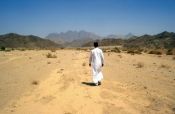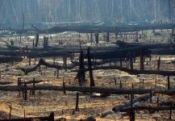Earth Policy Release
www.earth-policy.org/index.php?/book_bytes/2010/pb4ch02_ss2
By Lester R. Brown
Earth Policy Release
Book Byte
September 28, 2010
The thin layer of topsoil that covers the planet's land surface is the foundation of civilization. This soil, typically 6 inches or so deep, was formed over long stretches of geological time as new soil formation exceeded the natural rate of erosion. But sometime within the last century, as human and livestock populations expanded, soil erosion began to exceed new soil formation over large areas.
This is not new. In 1938, Walter Lowdermilk, a senior official in the Soil Conservation Service of the U.S. Department of Agriculture, traveled abroad to look at lands that had been cultivated for thousands of years, seeking to learn how these older civilizations had coped with soil erosion. He found that some had managed their land well, maintaining its fertility over long stretches of history, and were thriving. Others had failed to do so and left only remnants of their illustrious pasts.
In a section of his report entitled "The Hundred Dead Cities," he described a site in northern Syria, near Aleppo, where ancient buildings were still standing in stark isolated relief, but they were on bare rock. During the seventh century, the thriving region had been invaded, initially by a Persian army and later by nomads out of the Arabian Desert. In the process, soil and water conservation practices used for centuries were abandoned. Lowdermilk noted, "Here erosion had done its worst....if the soils had remained, even though the cities were destroyed and the populations dispersed, the area might be re-peopled again and the cities rebuilt, but now that the soils are gone, all is gone."
Wind and water erosion take a toll. The latter can be seen in the silting of reservoirs and in satellite photographs of muddy, silt-laden rivers flowing into the sea. Pakistan's two large reservoirs, Mangla and Tarbela, which store Indus River water for the country's vast irrigation network, are losing roughly 1 percent of their storage capacity each year as they fill with silt from deforested watersheds.
Ethiopia, a mountainous country with highly erodible soils, is losing close to 2 billion tons of topsoil a year, washed away by rain. This is one reason Ethiopia always seems to be on the verge of famine, never able to accumulate enough grain reserves to provide meaningful food security.
Soil erosion from the deterioration of grasslands is widespread. The world's steadily growing herds of cattle and flocks of sheep and goats forage on the two fifths of the earth's land surface that is too dry, too steeply sloping, or not fertile enough to sustain crop production. This area supports most of the world's 3.3 billion cattle, sheep, and goats, all ruminants with complex digestive systems that enable them to digest roughage, converting it into beef, mutton, and milk.
Credit: iStock Photo/stevenallan
An estimated 200 million people make their living as pastoralists, tending cattle, sheep, and goats. Since most land is held in common in pastoral societies, overgrazing is difficult to control. As a result, half of the world's grasslands are degraded. The problem is highly visible throughout Africa, the Middle East, Central Asia, and northwest China, where the growth in livestock numbers tracks that in human numbers. In 1950, Africa was home to 227 million people and 273 million livestock. By 2007, there were 965 million people and 824 million livestock.
Nigeria, Africa's most populous country, is losing 351,000 hectares (867,000 acres) of rangeland and cropland to desertification each year. While Nigeria's human population was growing from 37 million in 1950 to 148 million in 2007, a fourfold expansion, its livestock population grew from roughly 6 million to 102 million, a 17-fold jump. With the forage needs of Nigeria's 16 million cattle and 86 million sheep and goats exceeding the sustainable yield of grasslands, the northern part of the country is slowly turning to desert. If Nigeria continues toward its projected 289 million people by 2050, the deterioration will only accelerate.
Iran, with 73 million people, illustrates the pressures facing the Middle East. With 8 million cattle and 79 million sheep and goats—the source of wool for its fabled rug-making industry—Iran's rangelands are deteriorating from overstocking. In the southeastern province of Sistan-Balochistan, sand storms have buried 124 villages, forcing their abandonment. Drifting sands have covered grazing areas—starving livestock and depriving villagers of their livelihood.
Neighboring Afghanistan is faced with a similar situation. The Registan Desert is migrating westward, encroaching on agricultural areas. A U.N. Environment Programme (UNEP) team reports that "up to 100 villages have been submerged by windblown dust and sand." In the country's northwest, sand dunes are moving onto agricultural land in the upper reaches of the Amu Darya basin, their path cleared by the loss of stabilizing vegetation from firewood gathering and overgrazing. The UNEP team observed sand dunes 15 meters high blocking roads, forcing residents to establish new routes.
China faces similarly difficult challenges. After the economic reforms in 1978 that shifted the responsibility for farming from large state-organized production teams to farm families, China's cattle, sheep, and goat populations spiraled upward. While the United States, a country with comparable grazing capacity, has 97 million cattle, China has a slightly smaller herd of 82 million. But while the United States has only 9 million sheep and goats, China has 284 million. Concentrated in China's western and northern provinces, sheep and goats are destroying the land's protective vegetation. The wind then does the rest, removing the soil and converting productive rangeland into desert.
China's desertification may be the worst in the world. Wang Tao, one of the world's leading desert scholars, reports that from 1950 to 1975 an average of 600 square miles turned to desert each year. By century's end, nearly 1,400 square miles (3,600 square kilometers) were going to desert annually. Over the last half-century, some 24,000 villages in northern and western China have been entirely or partly abandoned as a result of being overrun by drifting sand.
China is now at war. It is not invading armies that are claiming its territory, but expanding deserts. Old deserts are advancing and new ones are forming like guerrilla forces striking unexpectedly, forcing Beijing to fight on several fronts.
Soil erosion often results from the demand-driven expansion of cultivation onto marginal land. Over the last century or so there were massive cropland expansions in two countries—the United States and the Soviet Union—and both ended in disaster.
During the late nineteenth century, millions of Americans pushed westward, homesteading on the Great Plains, plowing vast areas of grassland to produce wheat. Much of this land—highly erodible when plowed—should have remained in grass. This overexpansion culminated in the 1930s Dust Bowl, a traumatic period chronicled in John Steinbeck's novel The Grapes of Wrath. In a crash program to save its soils, the United States returned large areas of eroded cropland to grass, adopted strip-cropping, and planted thousands of miles of tree shelterbelts.
The second major expansion came in the Soviet Union beginning in the mid-1950s. In an all-out effort to expand grain production, the Soviets plowed an area of grassland larger than the wheat area of Australia and Canada combined. The result, as Soviet agronomists had predicted, was an ecological disaster—another Dust Bowl. Kazakhstan, where the plowing was concentrated, has abandoned 40 percent of its grainland since 1980. On the remaining cultivated land, the wheat yield per acre is one sixth of that in France, Western Europe's leading wheat producer.
Credit: iStock Photo/Brasil2
A third massive cropland expansion is now taking place in the Brazilian Amazon Basin and in the cerrado, a savannah-like region bordering the basin on its south side. Land in the cerrado, like that in the U.S. and Soviet expansion, is vulnerable to soil erosion. This cropland expansion is pushing cattle ranchers into the Amazon forests, where ecologists are convinced that continuing to clear the area of trees will end in disaster. Reporter Geoffrey Lean, summarizing the findings of a 2006 Brazilian scientific symposium in London's Independent, notes that the alternative to a rainforest in the Amazon would be "dry savannah at best, desert at worst."
Civilization depends on fertile soils. Ultimately, the health of the people cannot be separated from the health of the land. Conserving and rebuilding soils will be covered in the next Plan B 4.0 Book Byte.# # #
Adapted from Chapter 2, "Population Pressure: Land and Water," in Lester R. Brown,
Plan B 4.0: Mobilizing to Save Civilization (New York: W.W. Norton & Company, 2009), available on-line at www.earth-policy.org/index.php?/books/pb4
Additional data and information sources at www.earth-policy.org
Feel free to pass this information along to friends, family members, and colleagues!
1350 Connecticut Ave. NW, Suite 403
Washington, DC 20036
www.earth-policy.org

A personal quest to promote the use of wind energy and hydrogen technology in the Great Lakes area of the United States. The Great Lakes area is in a unique position to become an energy exporting region through these and other renewable energy technologies. *Update 2014: Just do it everywhere - Dan*
Saturday, October 02, 2010
Earth Policy Release -- Civilization's Foundation Eroding
On 9/28/2010 9:00 AM, Earth Policy Release wrote:



No comments:
Post a Comment
Please do not promote businesses that are not about keeping the environment clean or renewable energy via comments on this blog. All such posts will be reported as spam and removed.